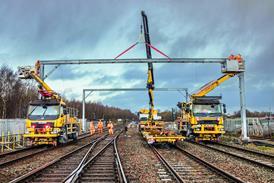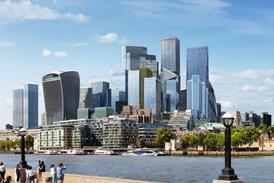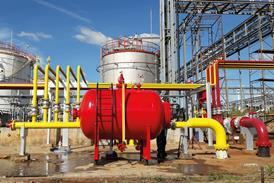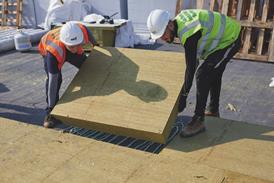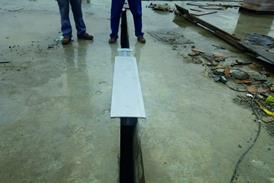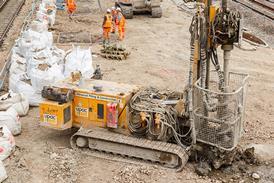- News

All the latest updates on building safety reformRegulations latest
- Focus
- Comment
- Programmes
- CPD
- Building the Future
- Jobs
- Data
- Subscribe
- Events

2024 events calendar
Explore now
Building Awards
Keep up to date
- Building Boardroom
- Previous slide
- 1 of 2
- Next slide
| Types of piling | |||
| Bored piling | |||
| Type | Shaft Diameter (mm) | Max depth (m) | Remarks |
| Tripod | 400-600 | 30 | Installed using simple, lightweight rigs. Ideal for confined spaces |
| Continuous flight auger (CFA) | 300-900 | 27.5 | Quiet, quick and economical method of boring. Only suitable for soft ground conditions |
| Rotary/bored | 300-3000 | 65 | Hydraulic rigs for load-bearing and walling solutions. Ideal for tougher ground conditions and obstructions |
| Driven piling | |||
| Type | Typical shaft size (mm2) | Max depth (m) | Remarks |
| Precast concrete | 230 and 270 | Unlimited | Installed by hydraulic hammers. Piles are cast in 5-15 m lengths. Greater depth achieved by joining piles |
| Driven steel section | 130-450 | Unlimited with splicing connections | Available in high strength or corrosion-resistant steel. Advantage of being able to penetrate bedrock. Steel lugs can be welded to the pile to give it a higher friction load capacity |
| Sheet piling | N/A | 18 m in cohesive soil. 12 m in granular soil | Sheet piling can be used as a cost-effective method of soil retention in temporary and permanent applications. |
| Diaphragm walling | |||
| Type | Typical wall thickness | Max depth (m) | Remarks |
| Diaphragm walling | 600-1500 | 50 | Ideal for constructing basement boxes, underpasses etc. Frequently used with bored piles and plunged columns in “top-down” construction. |
| Ground engineering | |||
| Type | Typical shaft diameter (mm) | Max depth (m) | Remarks |
| Mini | 100-300 | 35 | Ideal in confined areas |
| Anchors | 100-300 | 35 | Permanent and temporary applications |
| Soil nails | 100-300 | 25 | Ideal for stabilising slopes |
| Bored-pile retaining walls | |||
| Used for the construction of temporary or permanent retaining walls and for the provision of deep basements, underground structures and motorway cuttings. Bored-pile retaining walls are either “contiguous” or “secant”, the choice determined by soil type, ground water profile, maximum retained heights, programme, propping requirements, cost and life span. | |||
| Type | Shaft diameter (mm) | Centres | Max depth (m) |
| Contiguous | Up to 1200 for CFA. Up to 2400 for rotary | Generally 150 mm greater than diameter of the piles, thereby leaving gaps. | 20 (can be extended with larger pile spacing) |
| Secant | CFA/ rotary - generally 500-900 | Less than the diameter, creating interlocking | 20 (30 can be achieved but difficulties may be encountered) |
| Case studies | |||||||
| Location | Pile type | Average length (m) | Diameter (mm) | No. of piles | Approximate cost (£) | ||
| Per metre | Average per pile | Setup per pile | |||||
| London | Cast in-situ reinforced concrete, lined, auger bored | 28.5 | 750 | 99 | 50 | 1437 | 75 |
| Cast in-situ RC, CFA bored | 17.5 | 350 | 178 | 17 | 300 | 0 | |
| 17.5 | 450 | 14 | 30 | 530 | 40 | ||
| Cleveland | Cast in-situ RC, CFA bored | 13 | 450 | 153 | 30 | 390 | 25 |
| London | Cast in-situ, temporary casing, rotary bored | 15 | 320 | 172 | 46 | 687 | 30 |
| Bristol | Mini piles | 19 | 300 | 156 | 67 | 1265 | 36 |
| Driven RC square section | 13 | 285 x 285 | 333 | 21 | 275 | 36 | |
| Manchester | RC secant pile wall, CFA/rotary bored | 18 hard | 880 | 348 | 137 | 1717 | included |
| 7 soft | 750 | ||||||
| London | RC secant pile wall, CFA/rotary bored | 17 hard | 600 | 525 | 107 | 1496 | included |
| 11 soft | 600 | ||||||
| London | Cast in-situ RC, rotary bored | 35 | 600-1050 | 127 | 198 | 6944 | 55 |
| Costs exclude general preliminaries. Costs current at fourth quarter 2004 | |||||||


